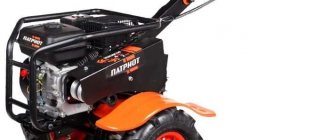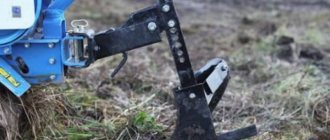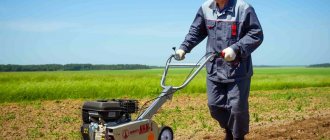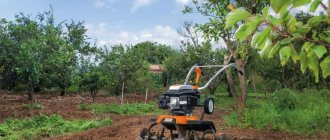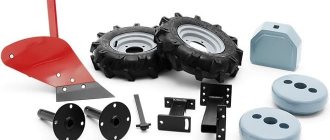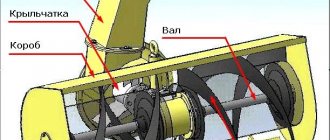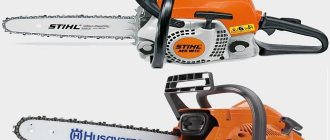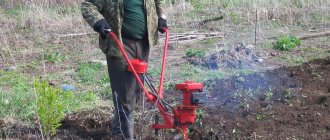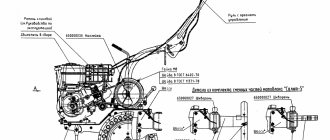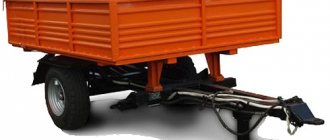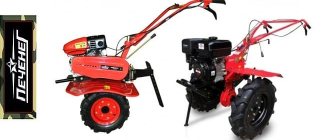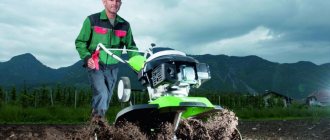About 30 years ago, the industry was not engaged in serial production of walk-behind tractors. They were not in demand on collective farms. The land was cultivated using wheeled and tracked tractors. Later, craftsmen were found who built strange units that aroused the envy and surprise of their neighbors. These homemade machines were the first walk-behind tractors. Today, plowing with an industrial walk-behind tractor does not surprise anyone, although envy remains.
Small universal units are used on farmers' plots, farmsteads of rural residents, and dachas. They replace several types of equipment, performing their work. Before purchasing a device, you need to think about its use on the farm.
Choosing a walk-behind tractor for plowing
When purchasing a walk-behind tractor for plowing land, you need to remember about other jobs that it can perform. The mechanism with a motor not only plows, cultivates and hills, but also transports loads, removes garbage and snow from the territory, and mows the grass. Watering the beds and harvesting the crops in the fall are operations that are also subject to the walk-behind tractor. Some specimens have a shaft to which various equipment is attached, capable of sawing and chopping wood, pumping water, and providing electricity. This is the difference between walk-behind tractors and cultivators.
Units for plowing land are available in 3 varieties: light, medium and heavy. Products of medium and light classes are intended for everyday use. Their weight ranges from 50-100 kg. They are equipped with engines with a capacity of 4-8 liters. With. Most units have several forward and reverse gears. Heavy-duty walk-behind tractors work on farm lands. They weigh more than 100 kg and are equipped with an engine with a power of over 8 hp. With.
The choice of a mechanical assistant for tillage is related to the number of functions it performs, the area of the site and the type of soil. The denser the soil, the heavier and more powerful the unit will be needed to plow the land. Its weight must be selected from 95 kg. The best products are equipped with diesel engines. They have a high traction force, a long service life, and diesel consumes less fuel. But when the ambient temperature drops to +2˚С and below, the engine is more difficult to start.
For a cultivated area of up to 15 acres, a walk-behind tractor is needed with a processing width of 70-80 cm and an engine with a power of 3-4 liters. With. For 15-40 acres, a unit with a processing width of up to 90 cm and a power of 7 liters is suitable. With. If the land area is more than 40 acres and up to 1 hectare, it can be plowed with a unit with an engine of over 9 liters. With. and a working width of 1 m.
You can purchase a large set of equipment along with the main walk-behind tractor. But it is best to choose the necessary devices: lawn mower, motor pump, snow blower, potato digger. For snow removal, a product with a gasoline engine is purchased. To transport goods, you need wheels with a diameter of 45 cm. It is good if there are height-adjustable handles.
The most expensive part of a walk-behind tractor is the engine. Domestic units are equipped with imported motors. Saving on the engine leads to frequent repairs, which are more expensive than the cost of the engine. High-quality engines are produced by:
- GreenField (Greenfield);
- Subaru (Subaru);
- Honda (Honda);
- Forza (Forza);
- BRIGGS & STRATTON.
All manufactured engines are two-stroke and four-stroke. The latter have proven themselves to be reliable and economical. When choosing an engine, preference should be given to engines with a disc clutch and a serviceable gearbox. These products are the most functional and reliable. It is better to choose gear reducers. Worm drive systems often overheat during operation and require the unit to be stopped every 20 minutes.
The best light-duty walk-behind tractors:
- Salyut (Russia) with Japanese engine;
- walk-behind tractor Neva MB-3S (Russia) with a Subaru engine.
These machines are suitable for cultivating land on farms and small plots of land.
Middle class products:
- Cayman (France) with a 6 hp Robin-Subaru engine. With. Has gears: forward - 2, backward - 1. Plowing depth - 32 cm, width - 90 cm.
- Neva and Cascade are produced by domestic manufacturers and are equipped with an American Briggs & Stratton engine.
- Centaur (China) with a 7 hp gasoline engine. With. Plows to a depth of 30 cm, the width of the passage is 100 cm.
Heavy machinery:
- Scout;
- Belarus;
- Bison
These units are equipped with high-quality American or Japanese-made diesel engines, equipped with a gear reducer and disc clutch. 4 forward and 2 reverse gears allow you to work with various attachments and transport loads.
Diesel walk-behind tractor CHAMPION DC1193E 9.5 hp.
Photo: https://beru.ru
A device for cultivating and loosening soil with high power. Can be used on areas of any size. The powerful motor provides effective results on soil of any density, including clay. Can be paired with any equipment. The controls are simple: all the necessary elements are located on the handles.
Diesel walk-behind tractor CHAMPION DC1193E 9.5 hp.
Advantages:
- power
- convenient control
- easy disassembly for transportation
- high speed
- high-quality cutters
Flaws:
- lack of differential and reverse
- need for refueling during long-term work
Typical mistakes when choosing a walk-behind tractor
Many inexperienced farmers, when buying a walk-behind tractor for cultivating the soil on their plot, thoughtlessly focus only on cost and appearance. This approach can lead to breakdown of the agricultural unit or inconvenience during its use. Let's look at the main mistakes when buying a walk-behind tractor, and tips that will help you make the right choice.
- When the future owner of motorized equipment for cultivating the land is not aware of the size of his plot and the types of soil on it. For example, for a summer cottage plot of 6 acres, a light-class walk-behind tractor will be sufficient. Even if there is virgin soil on it, you can hire a tractor for plowing once rather than buy a heavy unit and experience inconvenience when using it in the future on a plot with a small area.
- When the farmer does not know exactly what attachment he will use. It is necessary to think in advance which tools will be needed first, and not try to choose a walk-behind tractor with the maximum number of attachments, which may not be useful later. Read specialized forums or watch video reviews of experienced users to compile a list of attachments, taking into account the manufacturer’s recommendations.
- You should select in advance a walk-behind tractor model from a trusted manufacturer, the build quality of which will not be in doubt. This is where reviews and testimonials about equipment will come to the rescue; you should not rely only on the consultant in the store. If you primarily focus on cost when purchasing, then when using a cheap unit the following disadvantages will appear:
- poor quality of metal and plastic;
- greatly inflated technical characteristics;
- short engine life;
- difficulty in assembling the walk-behind tractor;
- inconvenience and discomfort during operation: increased noise and vibration levels, heavy weight, non-ergonomic handle without the option of turning and adjusting.
Petrol walk-behind tractor Huter MK-9500 9.5 hp.
Photo: https://beru.ru
An agricultural implement designed for a wide range of tasks. Suitable for cultivating, loosening and leveling the soil. Demonstrates excellent results on areas of any size. Equipped with a high power four-stroke engine. It is possible to use different types of attachments.
Petrol walk-behind tractor Huter MK-9500 9.5 hp.
Advantages:
- robust housing
- high quality welding
- adjustment of processing depth
- oil sensor
- speed selection
- easy assembly
Flaws:
- speed too fast
- expensive components
Preparing the walk-behind tractor
The walk-behind tractor requires preparation for work: installing ground hooks, hanging and adjusting the plow.
Installation of ground hooks
Ground hooks are wheels with a diameter of at least 50 cm and a width of 18 cm. They are made of metal. First you need to prepare them along with additional axles. The walk-behind tractor is installed on a level place. The rubber wheels are turned away and ground hooks are placed in their place.
Hanging and adjusting the plow
The plow is attached to the unit using hitches of various designs. First, the hitch is attached to the walk-behind tractor using a kingpin. The fastening should not be strong, with a horizontal play of 5-6˚. If the connection is made firmly, when plowing the ground, the walk-behind tractor will deviate in different directions due to the uneven impact of the soil on the plow. This makes it difficult to control the unit.
The next step is to attach the plow to the hitch. It's better to do this with an assistant. It is not recommended to tighten the nuts completely so that the plow for the walk-behind tractor is adjusted correctly. This is an important operation. If done incorrectly, plowing with a walk-behind tractor will be of poor quality. To properly adjust the plow, the unit is installed on stands 20-25 cm high. They can be made from bricks or scraps of boards.
Ground hooks are installed on stands and fixed. The walk-behind tractor should not overweight. Set the plow bed to a position in which the heel is parallel to the ground. This can be adjusted using adjusting bolts. Now the stands can be removed and the control handles can be installed at the level of the operator’s belt.
At the last stage, the angle between the ground surface and the end of the plow is adjusted. The adjusting screw is unscrewed until the plow blade rests on the ground. Then its back must be raised 2.5 cm above ground level. If this is not done, it will be impossible to plow with a walk-behind tractor. The plowing depth is equal to the height of the stands when adjusted.
Starting a walk-behind tractor
Operation of diesel and gasoline engines begins with startup. Many owners of a newly purchased walk-behind tractor have no idea about this process. They do not read the purchase instructions, although they are included with each product. First you need to check the oil and fuel levels. This is done before each engine start.
If the oil level is insufficient, the entire engine can be damaged.
Two-stroke engines are fueled with gasoline and diluted oil. The proportions of oil and gasoline and the technique for mixing them are described in the instructions. A-92 or A-95 gasoline is poured into the fuel tank of a gasoline engine. The diesel engine runs on diesel fuel, which can be used in summer or winter. The instructions provide information about the temperature at which winter or summer diesel fuel should be used.
Immediately before launch, the clutch, reverse, gas, and steering control systems are checked. All connections in these systems should move with little force. To start a gasoline engine equipped with a manual starter, you need to open the valve on the gas tank. The choke lever is set to the “Start” position. When the ignition is turned off, the starter makes 3-5 movements. Then the ignition is turned on and the engine starts. The choke lever is set to the “Work” position.
If the engine is equipped with an electric starter, starting is easier. The ignition is turned on and the engine starts. Gasoline enters the carburetor under the action of an electric pump.
It is more difficult to start a diesel engine. There is air in its power system that must be expelled with an electric starter. When the air leaves the tubes and diesel fuel takes its place, then the engine will start. When starting with a manual starter, you need to open the fuel supply valves, set the gas and press the decompressor. After several strokes with the starter, the decompressor returns to its original position and the engine starts. You can operate under load only after the diesel engine has warmed up.
Plow hitch
This operation is quite complicated - it is best done with an assistant. To hang the plow, the walk-behind tractor is slightly raised above the ground. To do this, it is driven onto some stands with a height of at least 15 cm. It is with this procedure that preparation for the operation of small-scale mechanization equipment intended for plowing land, of any brand, should begin. Including such a popular one as, for example, the Neva walk-behind tractor. How to properly plow the land using this brand of equipment will be discussed below.
The hitch itself is made according to the instructions of the walk-behind tractor and plow manufacturers. When performing this operation, you need to ensure that the entire surface of the edge of the plowshare touches the ground. The plow stand should be positioned strictly vertically, and the beam should be positioned horizontally.
Of course, the equipment should also be adjusted according to the track width. To do this, you need to pay attention to how the plow share is located. Its right edge should be in line with the inner edge of the right wheel. In this case, the plow will cut the soil evenly and roll it off easily. The walk-behind tractor itself will go easier.
This is interesting: Walk-behind tractor for planting and harvesting potatoes
How to plow with a walk-behind tractor correctly
The engine is started, you can start plowing. To begin work, the walk-behind tractor is brought to the site. The boundaries of the first furrow are marked with a taut twine. The control knobs should be turned to the left to operate the unit from unplowed ground. The first furrow is made at low speed. This must be done carefully, without losing the orientation cord. Having reached the end of the site, check the plowing depth. It should be within 15-20 cm.
After this, the right wheel is placed in the furrow, engaged in first gear and continues to plow. The equipment is easy to use and the skill appears quickly. If the plowing depth is not satisfactory, you need to adjust the plow. When plowing, you need to constantly monitor the wheel in the furrow; it should not go beyond its limits. The ridge of the earth should be at a distance of 8-10 cm from the previous one. A well-adjusted walk-behind tractor moves smoothly, without jerking. You can't push him. With the development of skills, the plowing speed can be increased.
Sometimes the motor overheats. In this case, it needs to be turned off and cooled. When the soil is plowed, it is filled with oxygen. This affects the future harvest. Autumn plowing is useful. Plow with a walk-behind tractor before winter. In the spring, it remains to dig up some areas in the corners of the garden. For plowing, it is better to use medium and heavy class products.
How to plow with a walk-behind tractor and plow
Today, land owners often use technology. Plowing with a walk-behind tractor is much easier and faster than digging a garden with a shovel. The walk-behind tractor will plow in an hour and a half the entire area that would take a week to dig with a bayonet shovel. But for this you need to control the mechanism correctly. The unit along with attached implements needs:
- deliver to the place of work;
- replace rubber wheels with ground hooks;
- extended axles will give the mini-tractor additional stability;
- hang and adjust the plow;
- start the engine;
- start plowing.
Proper plowing has advantages over other types of work:
- During this process, fertilizers can be applied;
- the plowed depth remains unchanged throughout the entire area;
- the soil is saturated with oxygen and moisture;
- weed growth slows down;
- productivity doubles;
- time is saved.
Operating a walk-behind tractor is simple: you need to walk next to it and use the handles to adjust the direction of its movement. The weight of the unit must be at least 70 kg. Plowing can be done using the Neva walk-behind tractor and other mechanisms. A lighter unit will not pull the plow.
This type of plowing also has disadvantages:
- Do not plow areas with deep roots;
- the fertile layer gradually fades away and loses quality.
The evenness of plowing can be adjusted by the speed of the mini-tractor.
How to plow with cutters
Small areas are best treated with a cultivator. Instead of a cultivator, walk-behind tractors with cutters are also used. They are included in the package or purchased separately. They are adjusted horizontally. This adjustment prevents the formation of waves from the ground. Processing is carried out 1 time. After double cultivation, the soil becomes caked. Saber-shaped cutters are often used, sometimes in the form of crow's feet. The cutters work accurately and with high quality. Their disadvantage is their low strength, leading to frequent repairs.
Plowing the land with a walk-behind tractor with an adapter
The quality of plowing improves if the plow is turned into a module for transport and arable purposes. The adapter is a kind of trailer. The functionality of a unit with an adapter is comparable to a tractor and its capabilities. Plowing is easy but slow. To plow virgin soil, you need a walk-behind tractor weighing more than 100 kg. Wheel weights may be needed. Plowing is carried out in several stages. At each stage, the land is cultivated to great depth. Damp soil is easier to work with.
In conclusion, it should be recalled that every year you need to change the direction of plowing. Walk-behind tractors Neva, Khoper, MTZ, Centaur and some other brands can plow landfills, hill up potato crops and perform a whole range of other work on a plot of land and in the yard. For autumn harvesting, a canopy is used that lifts the soil and passes it through the grate. The tubers remain on top.
Did our tips help you? What criteria do you pay attention to first when choosing a walk-behind tractor?
Gasoline walk-behind tractor KaDvi Oka MB-1D2M7 6.5 hp.
Photo: https://beru.ru
A good inexpensive walk-behind tractor with a power take-off shaft. Equipped with two pneumatic wheels. It can be used separately, as well as in combination with mounted and trailed equipment. This allows it to be used all year round. The model can withstand temperatures down to -25°C, so it can be used for snow removal if you have the necessary equipment. The device is equipped with several gears, which allows you to choose the best option for different jobs.
Gasoline walk-behind tractor KaDvi Oka MB-1D2M7 6.5 hp.
Advantages:
- durable metal housing
- high power
- fast acceleration up to 9 km/h
- low fuel consumption
Flaws:
- noisy work
Recommendations
To ensure that working with a walk-behind tractor is easy and soil cultivation is effective, you must follow a number of simple recommendations.
- It is better to cultivate plots up to 6 acres in size using cultivators. But if you decide to use a walk-behind tractor, then instead of a plow you should use saber-shaped or claw cutters.
- It is recommended to use a mounted plow when plowing fields larger than 1 hectare. However, it is also better to process the edges of areas and places with complex geometry using cutters.
- During operation, it is necessary to carefully monitor the condition of the equipment and prevent oil leakage from the transmission. Otherwise, harmful liquid will enter the treated soil and cause partial contamination.
- When plowing virgin lands, as well as when cultivating rocky and clayey soils, it is necessary to use weighting agents. Otherwise, there is a high risk that the walk-behind tractor will start jumping on the virgin soil and deep plowing will require a lot of effort.
- When using cutters, it is recommended to equip their ends with protective discs. This will reduce the likelihood of cultivating adjacent lands and will allow plowing strictly along the boundaries of the site.
- To reduce the strain on hearing, you should use special headphones or earplugs, and to partially neutralize vibration, you should wear mittens. In addition, when plowing, it is necessary to move on the leeward side, which will minimize the harmful effects of exhaust gases. If you have to plow in a large greenhouse, then you should ensure good ventilation of the room. To do this, it is necessary to open all windows and doors, and also periodically turn off the engine and ventilate the greenhouse.
- Filling the fuel tank, as well as changing the engine oil, should only be done with the engine turned off. In this case, it is advisable to pass the fuel through a funnel with a special filter.
- Operating the walk-behind tractor near an open fire and wiping it with a rag soaked in gasoline is strictly prohibited.
Plowing a plot with a walk-behind tractor helps to significantly facilitate the tillage process, improves the overall condition of the soil, increases productivity and significantly reduces the time of work.
See the video below about plowing the land with a walk-behind tractor.
